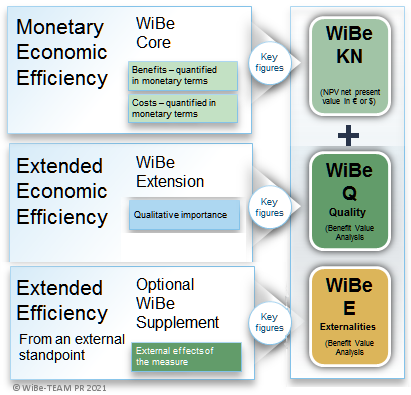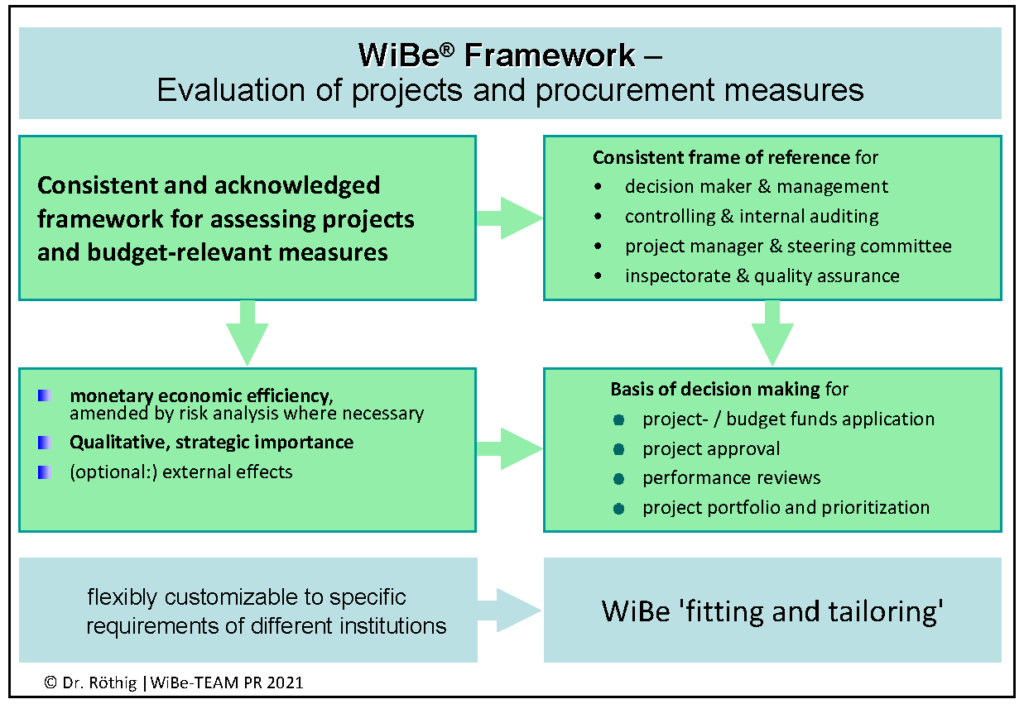Welcome to the German WiBe Framework

Justifying IT projects –
Economic efficiency assessments with WiBe 5.0
What’s economic efficiency, how can it be determined?
The principle of economic efficiency is based on achieving the most favourable relationship between the set purpose and the means used to attain it, i.e.: the benefits anticipated from an IT project should stand in highest ratio possible to the anticipated costs for attaining them.
The scientific tool for reaching this equation is the WiBe® Framework, taken from Wirtschaftlichkeits-Betrachtung, the German term for economic efficiency assessment. This is applied to individual projects and procurement measures and thereby distinguishes itself from periodic cost and activity accounting.
The WiBe Framework is already internationally acknowledged for its reliable economic efficiency assessments.Some of the planning questions it answers include:
- Which costs and benefits will occur from this project within a specified time?
- Which budget-relevant outcomes are expected from the project?
- Which further qualitative effects of importance can be derived?
- Why is it advisable to accomplish this IT project at this time?
The WiBe® Framework extrapolates the traditional project considerations and provides solid statements as to the economic efficiency of the measures planned.
Because economic efficiency assessment deals with assumptions about the future, the approach taken must be methodical and transparent – and its procedure organized about a common framework.
- Monetary evaluations constitute the core of each assessment, thus the method of net present value is recommended as the most suitable procedure. All future disbursements and deposits of an IT measure are discounted to the base year of the calculation, i.e., the year in which the IT measure is to commence. The sum of all net values within the calculation period represents the cumulative net value. If the sum is favorable, the project is economically efficient.
- Non monetary, qualitative evaluations supplement WiBe® core calculations by describing additional effects of the IT measure which cannot be measured in money. A benefits analysis, weighing all qualitative criteria with respect to their relative importance, is given a score on a scale from 0 to 10 to reflect the value of benefits. The higher the score, the better the qualitative prognosis for pending IT measures.
What determines an IT project’s extended economic efficiency?
The extended economic efficiency is determined by measuring the impact of various criteria on a project, such as:
-
-
- Cost and benefit parameters as quantified in monetary terms,
- Strategic quality improvement through implementation of a new IT system,
- The external impact an IT project will have on other institutions.
-
Which factors are necessary when projecting by the WiBe®?
To ensure the highest feasibility and integrity, all potential factors must be carefully projected and then comprehensively and methodically calculated. These are
- Profitability: economy of cost vs. benefit
All parameters defining cost and benefit which are capable of being quantified in monetary terms are of central importance.
- Investment & development costs
These are the one-time, initial expenditures made primarily for hardware and software, installation & systems implementation.
- Operating costs & benefits
These are ongoing costs reflecting consumable materials, personnel expenditures, maintenance and/or system updating, etc. The analysis assesses the efficiency of each cost criterion within the new system, indicating the savings attainable through discontinuation of the old process. The end balance shows additional vs. fewer or lower operating costs and is reflected in the subsequent cost-benefit calculation.
The calculated or estimated figures are discounted from the base year of calculation and form the net present value of the IT project (‘WiBe KW’). If the result is favourable, the project is economically efficient.
Aside from monetary impacts there are further evaluations which serve to determine the extended economic efficiency of the IT project. These concern the quailtative aspects which are detailed in a benefit analysis.
- Urgency surrounding the IT measure (version 4.1., not included in version 5.0)
The urgency called for in replacing a system currently in use is an important factor in the assessment. What about reliable, continuous maintenance? Are there restrictions for further expansion, personnel bottlenecks or interface problems? Will existing legal restraints remain valid, or will system replacement facilitate a new solution?
- Qualitative, strategic importance

The qualitative-strategic relevance of the new solution is a central criterion. For example, how will the solution fit into the sector’s overall development? How significant will the quality increase be upon completion of the specialized tasks? These and numerous further questions are asked and evaluated.
- External effects of the IT measure
The IT solution can affect (intentionally or non-intentionally) external parties and institutions substantially. These ‘external effects’ have to be considered if they are more than just incidental. For example, how is user friendliness from the customer side? Does the customer gain any direct economic benefit?
How do the WiBe ® key data figures simplify assessment?
WiBe generated key data figures deliver a set of rules decisive for the effective launching of individual IT projects. For example, when positive net present value shows the IT project to be economically efficient even before consideration of strategic importance or external effects; commencement with the project is recommended.
Likewise, a negative net present value marks the IT project as planned to be inefficient in a monetary sense. However, projects can be qualified as efficient in an extended sense when key data figures regarding quality index and an optional external effects analysis surpass predefined thresholds.
(WiBe® software offers a variety of report templates for the presentation of economic efficiency assessments and results. WiBe® software is browser based and can be implemented as an intranet solution or by Software as a Service (SaaS)).
WiBe Framework: flexible …
The WiBe® concept and the accompanying WiBe® software are adaptable to the requirements of both individual institutions and their varying projects. Easily navigating through the WiBe framework, the user manages the assessment with ease, certain that all aspects relevant to the evaluation have been factored systematically.
